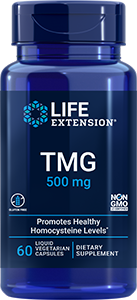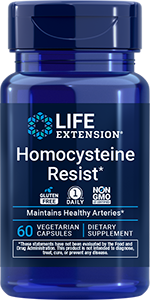
What Are TMG Supplements?
Published: September 2023
You may never have heard of the dietary supplement TMG. Or, you may have heard the name in passing and thought, "TMG? Isn't that a gossipy media company?" Or maybe it sounds like one of the original hip-hop groups from the 1980s? Nope! All the same, TMG, which is short for trimethylglycine, probably does deserve TMZ and Run DMC-level fame because of the supplement's legendary benefits for so many aspects of your health—from your heart to your liver to each and every cell.
To understand what this nutrient can do for you, let's first explain what TMG is, how it works, and what it does.
What is trimethylglycine (TMG)?
Trimethylglycine is a substance made in the body that's involved in liver function and in the metabolism of homocysteine, an amino acid that we need to have the right balance of to maintain heart and brain health.
Now let's address the elephant in the room: what is up with the long name trimethylglycine? Let's break down the word: "tri" means three, "methyl" (sometimes called "methyl groups") is a small molecule made of one carbon and three hydrogens, and "glycine" is an amino acid. Combine all those together and you've got three of those little methyl groups surrounding glycine.
To make things more confusing, trimethylglycine is also sometimes called "betaine," "betaine TMG," or even the funny sounding "betaine anhydrous TMG." (Not to be confused with the Notorious BIG.)
These terms are interchangeable, but just as a rose by any other name would still smell as sweet, whether you're calling it betaine, glycine betaine, TMG, or "Bob," this nutrient would still be full of health benefits. Let's talk about what those health benefits are.
Health benefits of TMG
So why do people supplement with TMG? We can think of plenty of reasons—five big ones, to be exact.
Healthy homocysteine levels
When we talk about the health benefits of TMG, the point that usually gets the most attention is its potent ability to help maintain healthy homocysteine levels. But what does that mean? Homocysteine is a breakdown product of the amino acid methionine—which your body does need…it just can't have too much of it.
Methionine is an essential amino acid that is a precursor to healthy compounds like cysteine, and the heart healthy amino acid taurine, and the mood and liver compound S-adenosyl methionine (SAMe). But the right balance is key. Fortunately, some nutrients can have a positive influence on the amount of homocysteine you have in your body: TMG, as well as B vitamins folate, B12, and B6.
Why does having a healthy homocysteine balance matter? Your heart health and the wellness of your blood vessels and brain depend upon it, that's why!
Is "Betaine" the Same as TMG?
Yes! TMG is kind of sneaky that way. It has lots of aliases. It goes by TMG, trimethylglycine, betaine, betaine anhydrous TMG, betaine TMG…but these all mean the same thing: a glycine amino acid surrounded by three methyl groups.
"Betaine supplements" have the exact same benefits as "TMG supplements," because they're all just different names for the same heart-healthy compound.
But! We should mention that there are forms of betaine that aren't the same as TMG; this happens when glycine isn't the central compound. However, if it's in your grains or spinach, or in a dietary supplement bottle, betaine and TMG will always be the same thing.
Metabolism must-have
We all want to have a healthy metabolism! You might think of this term with regards to weight management, but really, that's only a small piece of the puzzle. Metabolism is a big part of what keeps our heart, blood vessels, eyes and brain healthy, so we can embrace and enjoy all life has to offer. So, it's interesting that in a study in older individuals (average age 73) that measured plasma levels of betaine, higher betaine in the blood correlated with a better cardiometabolic profile. This included maintaining healthy levels of lipids and maintenance of better overall metabolic health.
Keeps your liver healthy
Speaking of metabolism, let's talk about the master metabolic regulator known as the liver. When our liver is healthy and supported by good lifestyle choices, we tend to be pretty healthy.
Maybe not so surprisingly, this liver-metabolism connection is an area where TMG may be able to help us. Betaine has been and continues to be studied for various aspects of liver health, and this promising liver helper could be just the thing to support optimal liver function.
Essential for cellular health
All of your cells contain betaine, and need it to function and exist. That sounds dramatic, but betaine (AKA trimethylglycine) is literally necessary for life. Here's why: trimethylglycine is an osmolyte. This means that it is essential to fluid and chemical balance inside your cells. On top of that, betaine protects cells against other forms of stress, including oxidative stress from free radicals.
Promotes a healthy inflammatory response
A healthy inflammatory response is important to maintaining health all year long, and it's also crucial for healthy aging. A survey study in healthy adults found that those with a relatively high dietary intake of betaine had healthy levels of the inflammatory biomarkers C-reactive protein and of TNF-alpha. They also maintained healthy levels of homocysteine.
Now, a diet high in healthy whole grains, spinach, and beets (all foods that contain TMG) will help with healthy levels of many of these factors anyway. But it's definitely possible that it was the betaine content that gave the diet that extra boost!
Explore Our Best Heart Health Supplements
What does TMG do in the body?
There are three main roles of TMG within the body:
TMG helps your cells regulate their volume.
That's because trimethylglycine is an osmolyte. Osmolytes are necessary to keep cells healthy. You can think of a cell like a water balloon (that's a loose analogy! Your cells aren't very much like water balloons), and the cell membrane (the balloon) needs to have not too much or too little fluid and other contents inside of it.TMG is a "methyl donor"—that's why it helps with homocysteine balance, SAMe production, and healthy gene expression.
Remember those three methyl groups in each molecule of TMG, the ones that put the "tri" in "trimethylglycine"? Those methyl groups can be "donated," or given up to another molecule that needs one. That's especially important for homocysteine metabolism, but also necessary to create S-adenosyl-methionine, or SAMe (which you may see spelled with one less hyphen, as S-adenosylmethionine), a compound that has been used for mood, liver, and joint health. Methyl groups are also critical to how your genes express themselves, an area of medical science called epigenetics.TMG is also an antioxidant.
It helps cells resist other kinds of biochemical stress, and even plays a role in nervous system health.
Where to get TMG naturally
It's a challenge to get this nutrient from food alone. There is some TMG in grains and grain-based products; the richest sources of betaine are the gluten-containing grains wheat, rye, and spelt, with a little bit less in two other similar grains: barley and oats. "Rich" is a relative term here, though, because you'd have to eat a lot of those grains in their whole form (not white flour) to get a fairly small amount of TMG.
Of the gluten-free grains, quinoa and amaranth are excellent sources. The only other significant dietary sources are spinach and beets. So you can get betaine from your diet, depending on what you eat, but it's not that easy.
Keep in mind that food nutrient content always varies depending on growing conditions, and it has been suggested that wheat grown in drier conditions—think Australian-grown wheat, if you're a down under denizen or a New Zealand kiwi (or just eating Aussie wheat crackers)—may have a higher betaine content.
Also, you can get some TMG in healthy greens like spinach—but the best way to get an effective dose is in a dietary supplement.
How to take TMG supplements
TMG supplementation can be added along with other supplements you take, with or away from meals, with some liquid—water is fine. If taking two 500 mg capsules at one meal is too much for your stomach, trying dividing it up so that you take one capsule with breakfast and one with another meal later in the day.
TMG is also available in powder form, allowing you to more easily control the dosage and to mix it in water, juice, or shakes and smoothies.
Pro tip: Not sure which heart-healthy supplement or regimen is right for you? Take our heart supplement quiz to learn more!
References
- Arumugam MK, et al. "Beneficial Effects of Betaine: A Comprehensive Review." Biology. May 2021. https://www.mdpi.com/2079-7737/10/6/456
- Atkinson W, et al. "Dietary and supplementary betaine: acute effects on plasma betaine and homocysteine concentrations under standard and postmethionine load conditions in healthy male subjects." Am J Clin Nutr. March 2008. https://pubmed.ncbi.nlm.nih.gov/18326594/
- Detopoulou P, et al. "Dietary choline and betaine intakes in relation to concentrations of inflammatory markers in healthy adults: the ATTICA study." Am J Clin Nutr. February 2008. https://pubmed.ncbi.nlm.nih.gov/18258634/
- Filipčev B, et al. "Betaine in Cereal Grains and Grain-Based Products." Foods. March 2018. https://www.ncbi.nlm.nih.gov/pmc/articles/PMC5920414/
- Gillies NA, et al. "Nutritional supplementation alters associations between one-carbon metabolites and cardiometabolic risk profiles in older adults: a secondary analysis of the Vienna Active Ageing Study." Eur J Nutr. February 2022. https://pubmed.ncbi.nlm.nih.gov/34240265/
- Lu XT, et al. "Effects of low-dose B vitamins plus betaine supplementation on lowering homocysteine concentrations among Chinese adults with hyperhomocysteinemia: a randomized, double-blind, controlled preliminary clinical trial." Eur J Nutr. June 2023. https://pubmed.ncbi.nlm.nih.gov/36717385/
- Mukherjee S. "Role of betaine in liver disease-worth revisiting or has the die been cast?" World J Gastroenterol. October 2020. https://www.ncbi.nlm.nih.gov/pmc/articles/PMC7579752/
- Rehman A, Mehta KJ. "Betaine in ameliorating alcohol-induced hepatic steatosis." Eur J Nutr. April 2022. https://pubmed.ncbi.nlm.nih.gov/34817678/
- Roe AJ, et al. "Choline and its metabolites are differently associated with cardiometabolic risk factors, history of cardiovascular disease, and MRI-documented cerebrovascular disease in older adults." Am J Clin Nutr. June 2017. https://pubmed.ncbi.nlm.nih.gov/28356272/
- Slow S, et al. "Dietary betaine and inflammation." Am J Clin Nutr. July 2008. https://www.sciencedirect.com/science/article/pii/S0002916523240642?via%3Dihub
- Yeroshkina K, et al. "Betaine consumption as a new clinical approach to treatment and prophylaxis of folate-related pathologies." Nutr Rev. May 2023. https://pubmed.ncbi.nlm.nih.gov/36164833/
Always be in the know!
Access the latest deals, wellness news, expert health tips & more!










